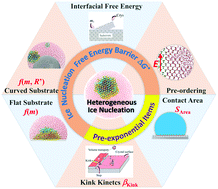当前位置:
X-MOL 学术
›
Chem. Soc. Rev.
›
论文详情
Our official English website, www.x-mol.net, welcomes your
feedback! (Note: you will need to create a separate account there.)
Control of ice nucleation: freezing and antifreeze strategies
Chemical Society Reviews ( IF 40.4 ) Pub Date : 2018-08-23 00:00:00 , DOI: 10.1039/c8cs00626a Zhisen Zhang 1, 2, 3, 4, 5 , Xiang-Yang Liu 1, 2, 3, 4, 5
Chemical Society Reviews ( IF 40.4 ) Pub Date : 2018-08-23 00:00:00 , DOI: 10.1039/c8cs00626a Zhisen Zhang 1, 2, 3, 4, 5 , Xiang-Yang Liu 1, 2, 3, 4, 5
Affiliation

|
Water freezing remains a perennial topic of great relevance to many important aspects of our lives; from the climate to human society and from economics to medicine, frozen water profoundly influences our living environment and life activities. There have been numerous publications on water freezing; however, confusion regarding the process of freezing remains. In this review, we mainly focused on the nucleation aspects of water freezing; in particular, we focused on the effect of the surface morphology and nanostructure of foreign bodies. This review covers the recent progress in ice nucleation and anti-freezing strategies within the framework of nucleation principles. In this regard, we first summarize the crystal nucleation theories. Due to high interfacial energy, ice crystallization is primarily controlled by heterogeneous nucleation events, because the homogeneous nucleation barrier of ice is extremely high. In addition to the interfacial energy, the interfacial morphology or nanostructure of foreign bodies plays a diverse role under different supercooling regimes due to the Gibbs–Thomson effect. This effect gives rise to the inverse homogeneous-like nucleation phenomenon, in which foreign bodies have little influence on the nucleation barrier. This ensures the accurate measurement of the nucleation barrier, critical size, and water–ice interfacial energy, in agreement with the latest studies based on a microemulsions approach, metadynamics, the mW model, etc. As a consequence, anti-freezing strategies can be implemented by reducing the nucleation rate through restriction of the contact area of the water/substrate interface, by increasing the heterogeneous nucleation barrier through modification of the interfacial properties of foreign particles, including the interfacial structure and the interaction between the water and foreign particles and by kink kinetics. Within this context, the anti-freezing mechanism of superhydrophobic substrates was reviewed. Therefore, it follows that by significantly reducing the contact area between the water and substrate, superhydrophobic materials can effectively reduce the heterogeneous nucleation rate. We hope that this review will provide a unified picture and guidance for future work on water freezing.
中文翻译:

冰核的控制:冷冻和防冻策略
冻结水仍然是与我们生活中许多重要方面息息相关的常年主题。从气候到人类社会,从经济学到医学,冷冻水深刻地影响着我们的生活环境和生活活动。关于水冷冻的出版物很多。然而,关于冷冻过程的困惑仍然存在。在这篇综述中,我们主要关注水冷冻的成核方面。特别是,我们着重研究了异物的表面形态和纳米结构的影响。这篇综述涵盖了在成核原理框架内冰成核和防冻策略的最新进展。在这方面,我们首先总结一下晶体成核理论。由于界面能高,冰晶的形成主要受异质成核事件的控制,因为冰的均匀成核势垒非常高。除了界面能之外,由于吉布斯-汤姆森效应,异物的界面形态或纳米结构在不同的过冷状态下也起着不同的作用。这种作用引起了逆均相状成核现象,其中异物对成核屏障的影响很小。与基于微乳化方法,元动力学,mW模型的最新研究相一致,这确保了对成核屏障,临界尺寸和水冰界面能的准确测量。由于吉布斯-汤姆森效应,异物的界面形态或纳米结构在不同的过冷状态下起着不同的作用。这种作用引起了逆均相状成核现象,其中异物对成核屏障的影响很小。与基于微乳化方法,元动力学,mW模型的最新研究相一致,这确保了对成核屏障,临界尺寸和水冰界面能的准确测量。由于吉布斯-汤姆森效应,异物的界面形态或纳米结构在不同的过冷状态下起着不同的作用。这种作用引起了逆均相状成核现象,其中异物对成核屏障的影响很小。与基于微乳化方法,元动力学,mW模型的最新研究相一致,这确保了对成核屏障,临界尺寸和水冰界面能的准确测量。等结果,防冻剂策略可以通过减小通过水/基材界面的接触面积的限制成核速率来实现,通过外来颗粒的界面性质的修饰增加异质成核屏障,包括界面水和异物之间的结构和相互作用以及通过扭结动力学。在此背景下,对超疏水基材的防冻机理进行了综述。因此,可以得出结论,通过显着减小水与基质之间的接触面积,超疏水材料可以有效地降低异相成核速率。我们希望这次审查能为今后的水冻结工作提供一个统一的图景和指南。
更新日期:2018-08-23
中文翻译:

冰核的控制:冷冻和防冻策略
冻结水仍然是与我们生活中许多重要方面息息相关的常年主题。从气候到人类社会,从经济学到医学,冷冻水深刻地影响着我们的生活环境和生活活动。关于水冷冻的出版物很多。然而,关于冷冻过程的困惑仍然存在。在这篇综述中,我们主要关注水冷冻的成核方面。特别是,我们着重研究了异物的表面形态和纳米结构的影响。这篇综述涵盖了在成核原理框架内冰成核和防冻策略的最新进展。在这方面,我们首先总结一下晶体成核理论。由于界面能高,冰晶的形成主要受异质成核事件的控制,因为冰的均匀成核势垒非常高。除了界面能之外,由于吉布斯-汤姆森效应,异物的界面形态或纳米结构在不同的过冷状态下也起着不同的作用。这种作用引起了逆均相状成核现象,其中异物对成核屏障的影响很小。与基于微乳化方法,元动力学,mW模型的最新研究相一致,这确保了对成核屏障,临界尺寸和水冰界面能的准确测量。由于吉布斯-汤姆森效应,异物的界面形态或纳米结构在不同的过冷状态下起着不同的作用。这种作用引起了逆均相状成核现象,其中异物对成核屏障的影响很小。与基于微乳化方法,元动力学,mW模型的最新研究相一致,这确保了对成核屏障,临界尺寸和水冰界面能的准确测量。由于吉布斯-汤姆森效应,异物的界面形态或纳米结构在不同的过冷状态下起着不同的作用。这种作用引起了逆均相状成核现象,其中异物对成核屏障的影响很小。与基于微乳化方法,元动力学,mW模型的最新研究相一致,这确保了对成核屏障,临界尺寸和水冰界面能的准确测量。等结果,防冻剂策略可以通过减小通过水/基材界面的接触面积的限制成核速率来实现,通过外来颗粒的界面性质的修饰增加异质成核屏障,包括界面水和异物之间的结构和相互作用以及通过扭结动力学。在此背景下,对超疏水基材的防冻机理进行了综述。因此,可以得出结论,通过显着减小水与基质之间的接触面积,超疏水材料可以有效地降低异相成核速率。我们希望这次审查能为今后的水冻结工作提供一个统一的图景和指南。











































 京公网安备 11010802027423号
京公网安备 11010802027423号